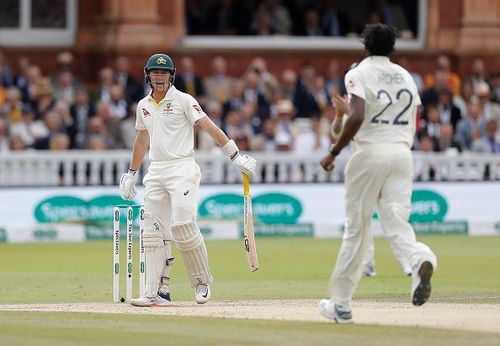
Accidental No.3 - Steve Smith's concussion substitute morphs into Aussie batting mainstay

In August, 2019, at the Mecca of cricket, England confronted Steve Smith as the former Australian skipper seemed primed to thwart the Three Lions’ attempt at redemption, again. Jofra Archer, a fast bowler, who was in the midst of a stellar international run himself, had other ideas as he kept rattling the visitors’ cage, courtesy a string of searing bouncers.
The barrage of short deliveries continued relentlessly and inevitably, Smith, who till that point, had seemed untroubled by the English bowling attack, cut a dizzy figure after being pinged by a pin-point bouncer.
Utterly distraught, the batsman walked back to the pavilion, still trying to make sense of what had unfolded. And, though he came out to resume his innings, the injury was just too serious to allow the right-hander to take further part in the encounter.
Subsequently, on the 18th of August, Marnus Labuschagne had made Test cricketing history, despite not facing a single delivery. However, when he came out to bat, he looked extremely tentative, which wasn’t a surprise considering he hadn’t mentally prepared himself for such a battle on the eve of the game. Ironically, he too copped a sharp bouncer from Archer as the latter grew from strength to strength.
Yet, that blow to the head just woke Labuschagne from his slumber. And, consequently, he has charted an unprecedented upward trajectory, meaning that several opposition bowlers have endured their fair share of sleepless nights.

Before making his bow in Test cricket, the right-handed batsman had primarily been looked upon as a potential batting all-rounder by Australia, a player capable of popping up with a few overs of leg-spin and one also equipped to bat in the middle order.
However, in his second coming as a cricketer, Labuschagne, akin to a certain Smith, has showcased that there exist several more strings to his bow than just spin bowling and the tendency to provide handy runs.
Throughout the latter part of 2019, the Queenslander portrayed immense steel and determination, traits that have somehow gone slightly amiss in the current Test era.
On countless occasions, he has been able to buckle down, bide his time and then land the decisive punch whenever the situation has demanded. Most importantly though, Labuschagne’s rise to stardom has meant that he has helped morph Australia’s batting order into one that isn’t solely dependent on David Warner and Smith.
In the recently concluded series against New Zealand and Pakistan, there were times when the aforementioned pair got out cheaply, at least by their standards, Yet, with the Queenslander in the mix, the Aussies were able to post totals that proved too steep an ask for the opposition.
Technically, Labuschagne, at this juncture, looks pretty sound. He leaves the ball outside off-stump adroitly and is rarely caught wafting at deliveries wide of the stumps. In turn, that forces the bowlers to bowl at his body, meaning that he can then access the leg-side, an area that brings him a majority of his runs.
Additionally, he boasts the ability to graft, an attribute that isn’t necessarily associated in the current era of batsmanship. The advent of T20s has directly contributed to numerous batsmen trying to impose themselves and looking for an option to hit their way out of trouble.
Yet, Labuschagne represents the clear anomaly, thereby compelling bowlers to prize out his wicket and evolve mechanisms to get the better of him, rather than waiting for the batsmen to indulge in a rash shot.
Thus, in many ways, the right-hander has managed to throw light on the cyclical nature of cricket, a discovery that could help people appreciate that the more old-fashioned or sometimes exasperatingly termed ‘archaic’ form of batting still holds a monumental place in Test cricket, especially when T20 cricket and its ideals dominate the scenery.
To put things into perspective, that very approach helped England conquer Cape Town a few days ago, with Dom Sibley starring courtesy a gritty knock of 133*.

Most tellingly though, Labuschagne, in light of his recent exploits, has highlighted the vast reserves of mental toughness he possesses. After all, not many are able to lead the pack despite being thrown to the wolves in testing times. And, Archer, especially a few months ago, represented a bowler firmly in his pomp.
For the past few years, the Australians’ propensity to favour slightly more flamboyant batsmen has meant that they’ve not zeroed in on players capable of handling the trials and tribulations of Test cricket efficiently.
Yet, the aforementioned Queenslander, who seemingly bucks that trend, has accorded them a healthy headache, wherein they might want to rejig their modus operandi just a shade.
And, consequently, it seems only fitting that the Aussies stumbled upon Labuschange as their ideal No.3, rather than earmarking him as a probable top-order batsman at the outset of his career.
But, if Australia’s accidental No.3 keeps churning out the runs, surely they wouldn’t be too concerned with how they pulled this particular rabbit out of their bag, would they?